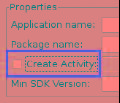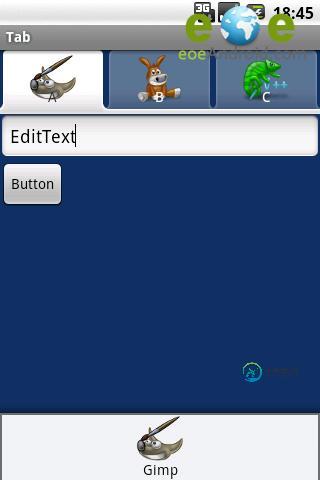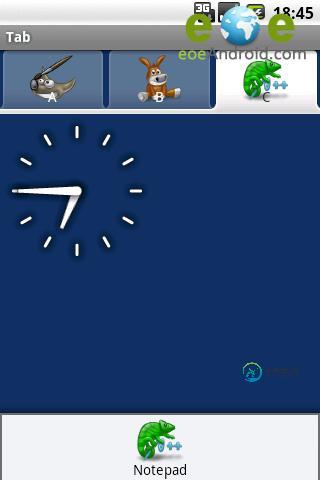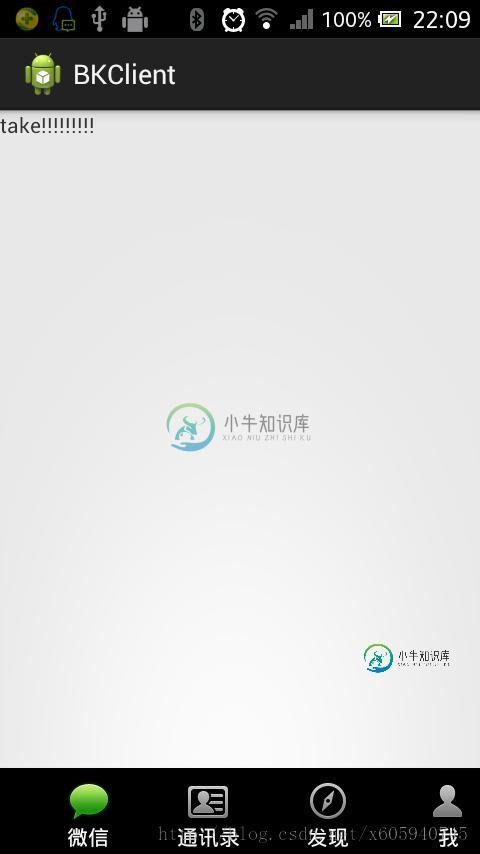实例讲解Android应用开发中TabHost的使用要点
Tab与TabHost:

这就是Tab,而盛放Tab的容器就是TabHost 。
如何实现??
每一个Tab还对应了一个布局,这个就有点好玩了。一个Activity,对应了多个功能布局。
新建一个Tab项目,注意,不要生成main Activity 。

注意IDE,这里不要选...
在包里面新建一个类MyTab,继承于TabActivity。
其实,TabActivity是Activity的子类
package zyf.tab.test;
import android.app.TabActivity;
public class MyTab extends TabActivity {
}
从父类继承OnCreate()入口方法
package zyf.tab.test;
import android.app.TabActivity;
import android.os.Bundle;
public class MyTab extends TabActivity {
@Override
protected void onCreate(Bundle savedInstanceState) {
// TODO Auto-generated method stub
super.onCreate(savedInstanceState);
}
}
在Manifest.xml文件中注册一下MyTab类(Activity)
<activity android:name=".MyTab">
<intent-filter>
<action android:name="android.intent.action.MAIN"></action>
<category android:name="android.intent.category.LAUNCHER"></category>
</intent-filter>
</activity>
这时候,需要设计一下标签页对应的布局,一般采用FrameLayout作为根布局,每个标签页面对应一个子节点的Layout
<?xml version="1.0" encoding="utf-8"?>
<!-- 这里是根节点布局 -- >
<FrameLayout xmlns:android="http://schemas.android.com/apk/res/android"
android:layout_width="fill_parent" android:layout_height="fill_parent">
<!-- 第一个Tab 对应的布局 -- >
<LinearLayout android:id="@+id/widget_layout_Blue"
android:layout_width="fill_parent" android:layout_height="fill_parent"
androidrientation="vertical" >
<EditText android:id="@+id/widget34" android:layout_width="fill_parent"
android:layout_height="wrap_content" android:text="EditText"
android:textSize="18sp">
</EditText>
<Button android:id="@+id/widget30" android:layout_width="wrap_content"
android:layout_height="wrap_content" android:text="Button">
</Button>
</LinearLayout>
<!-- 第二个Tab 对应的布局 -- >
<LinearLayout android:id="@+id/widget_layout_red"
android:layout_width="fill_parent" android:layout_height="fill_parent"
androidrientation="vertical" >
<AnalogClock android:id="@+id/widget36"
android:layout_width="wrap_content" android:layout_height="wrap_content">
</AnalogClock>
</LinearLayout>
<!-- 第三个Tab 对应的布局 -- >
<LinearLayout android:id="@+id/widget_layout_green"
android:layout_width="fill_parent" android:layout_height="fill_parent"
androidrientation="vertical">
<RadioGroup android:id="@+id/widget43"
android:layout_width="166px" android:layout_height="98px"
androidrientation="vertical">
<RadioButton android:id="@+id/widget44"
android:layout_width="wrap_content" android:layout_height="wrap_content"
android:text="RadioButton">
</RadioButton>
<RadioButton android:id="@+id/widget45"
android:layout_width="wrap_content" android:layout_height="wrap_content"
android:text="RadioButton">
</RadioButton>
</RadioGroup>
</LinearLayout>
</FrameLayout>
首先,应该声明TabHost,然后用LayoutInflater过滤出布局来,给TabHost加上含有Tab页面的FrameLayout
private TabHost myTabhost; myTabhost=this.getTabHost();//从TabActivity上面获取放置Tab的TabHost LayoutInflater.from(this).inflate(R.layout.main, myTabhost.getTabContentView(), true); //from(this)从这个TabActivity获取LayoutInflater //R.layout.main 存放Tab布局 //通过TabHost获得存放Tab标签页内容的FrameLayout //是否将inflate 拴系到根布局元素上 myTabhost.setBackgroundColor(Color.argb(150, 22, 70, 150)); //设置一下TabHost的颜色
接着,在TabHost创建一个标签,然后设置一下标题/图标/标签页布局
myTabhost.addTab(myTabhost.newTabSpec("TT")// 制造一个新的标签TT
.setIndicator("KK",getResources().getDrawable(R.drawable.ajjc))
// 设置一下显示的标题为KK,设置一下标签图标为ajjc
.setContent(R.id.widget_layout_red));
//设置一下该标签页的布局内容为R.id.widget_layout_red,这是FrameLayout中的一个子Layout
标签切换事件处理,setOnTabChangedListener
myTabhost.setOnTabChangedListener(new OnTabChangeListener(){
@Override
public void onTabChanged(String tabId) {
// TODO Auto-generated method stub
}
});
各个标签页的动态MENU
先把在XML中设计好的MENU放到一个int数组里
private static final int myMenuResources[] = { R.menu.phonebook_menu,
R.menu.addphone_menu, R.menu.chatting_menu, R.menu.userapp_menu };
在setOnTabChangedListener()方法中根据标签的切换情况来设置myMenuSettingTag
Override
public void onTabChanged(String tagString) {
// TODO Auto-generated method stub
if (tagString.equals("One")) {
myMenuSettingTag = 1;
}
if (tagString.equals("Two")) {
myMenuSettingTag = 2;
}
if (tagString.equals("Three")) {
myMenuSettingTag = 3;
}
if (tagString.equals("Four")) {
myMenuSettingTag = 4;
}
if (myMenu != null) {
onCreateOptionsMenu(myMenu);
}
}
然后onCreateOptionsMenu(Menu menu) 方法中通过MenuInflater过滤器动态加入MENU
@Override
public boolean onCreateOptionsMenu(Menu menu) {
// TODO Auto-generated method stub
// Hold on to this
myMenu = menu;
myMenu.clear();//清空MENU菜单
// Inflate the currently selected menu XML resource.
MenuInflater inflater = getMenuInflater();
//从TabActivity这里获取一个MENU过滤器
switch (myMenuSettingTag) {
case 1:
inflater.inflate(myMenuResources[0], menu);
//动态加入数组中对应的XML MENU菜单
break;
case 2:
inflater.inflate(myMenuResources[1], menu);
break;
case 3:
inflater.inflate(myMenuResources[2], menu);
break;
case 4:
inflater.inflate(myMenuResources[3], menu);
break;
default:
break;
}
return super.onCreateOptionsMenu(menu);
}
menu 布局
<?xml version="1.0" encoding="utf-8"?> <menu xmlns:android="http://schemas.android.com/apk/res/android"> <group android:id="@+id/group_a"><item android:id="@+id/item_a" android:icon="@drawable/gimp" android:title="Gimp"></item> </group> </menu>
运行效果



模仿微信导航实例:

<?xml version="1.0" encoding="utf-8"?>
<TabHost xmlns:android="http://schemas.android.com/apk/res/android"
android:id="@android:id/tabhost"
android:layout_width="match_parent"
android:layout_height="match_parent" >
<LinearLayout
android:layout_width="match_parent"
android:layout_height="match_parent"
android:orientation="vertical" >
<FrameLayout
android:id="@android:id/tabcontent"
android:layout_width="match_parent"
android:layout_height="0.0dip"
android:layout_weight="1.0" >
</FrameLayout>
<TabWidget
android:id="@android:id/tabs"
android:layout_width="match_parent"
android:layout_height="wrap_content"
android:visibility="gone" >
</TabWidget>
<RadioGroup
android:layout_width="match_parent"
android:layout_height="wrap_content"
android:layout_gravity="bottom"
android:background="@android:color/black"
android:orientation="horizontal" >
<RadioButton
android:id="@+id/talk"
style="@style/rbt_bottom"
android:drawableTop="@drawable/take_bottom"
android:text="@string/talk" />
<RadioButton
android:id="@+id/address"
style="@style/rbt_bottom"
android:drawableTop="@drawable/adrress_bottom"
android:text="@string/address" />
<RadioButton
android:id="@+id/find"
style="@style/rbt_bottom"
android:drawableTop="@drawable/find_bottom"
android:text="@string/find" />
<RadioButton
android:id="@+id/me"
style="@style/rbt_bottom"
android:drawableTop="@drawable/me_bottom"
android:text="@string/me" />
</RadioGroup>
</LinearLayout>
</TabHost>
<?xml version="1.0" encoding="utf-8"?> <selector xmlns:android="http://schemas.android.com/apk/res/android"> <item android:drawable="@drawable/n_address_l" android:state_checked="true" android:state_enabled="true"/> <item android:drawable="@drawable/n_address_h"/> </selector>
package com.android.xiong.bkclient;
import android.app.TabActivity;
import android.content.Intent;
import android.os.Bundle;
import android.widget.CompoundButton;
import android.widget.CompoundButton.OnCheckedChangeListener;
import android.widget.RadioButton;
import android.widget.TabHost;
@SuppressWarnings("deprecation")
public class MainActivity extends TabActivity implements
OnCheckedChangeListener {
private TabHost tabHost;
private Intent addressIntent;
private Intent meIntent;
private Intent takeIntent;
private Intent findIntent;
private RadioButton findBt;
private RadioButton addressBt;
private RadioButton meBt;
private RadioButton takeBt;
@Override
protected void onCreate(Bundle savedInstanceState) {
super.onCreate(savedInstanceState);
setContentView(R.layout.tabhostmain);
addressIntent = new Intent(this, AddressActivity.class);
meIntent = new Intent(this, MeActivity.class);
takeIntent = new Intent(this, TakeActivity.class);
findIntent = new Intent(this, FindActivity.class);
findBt = (RadioButton) findViewById(R.id.find);
addressBt = (RadioButton) findViewById(R.id.address);
meBt = (RadioButton) findViewById(R.id.me);
takeBt = (RadioButton) findViewById(R.id.talk);
tabHost =getTabHost();
tabHost.addTab(tabHost.newTabSpec("take").setIndicator("take")
.setContent(takeIntent));
tabHost.addTab(tabHost.newTabSpec("address").setIndicator("address")
.setContent(addressIntent));
tabHost.addTab(tabHost.newTabSpec("find").setIndicator("find")
.setContent(findIntent));
tabHost.addTab(tabHost.newTabSpec("me").setIndicator("me")
.setContent(meIntent));
findBt.setOnCheckedChangeListener(this);
meBt.setOnCheckedChangeListener(this);
takeBt.setOnCheckedChangeListener(this);
addressBt.setOnCheckedChangeListener(this);
}
@Override
public void onCheckedChanged(CompoundButton view, boolean ischeak) {
if (ischeak) {
switch (view.getId()) {
case R.id.talk:
tabHost.setCurrentTabByTag("take");
break;
case R.id.find:
tabHost.setCurrentTabByTag("find");
break;
case R.id.me:
tabHost.setCurrentTabByTag("me");
break;
case R.id.address:
tabHost.setCurrentTabByTag("address");
break;
default:
break;
}
}
}
}
<manifest xmlns:android="http://schemas.android.com/apk/res/android"
package="com.android.xiong.bkclient"
android:versionCode="1"
android:versionName="1.0" >
<uses-sdk
android:minSdkVersion="8"
android:targetSdkVersion="19" />
<application
android:allowBackup="true"
android:icon="@drawable/ic_launcher"
android:label="@string/app_name"
android:theme="@style/AppTheme" >
<activity android:name="com.android.xiong.bkclient.MainActivity">
<intent-filter>
<action android:name="android.intent.action.MAIN" />
<category android:name="android.intent.category.LAUNCHER" />
</intent-filter>
</activity>
<activity android:name="com.android.xiong.bkclient.AddressActivity"></activity>
<activity android:name="com.android.xiong.bkclient.FindActivity"></activity>
<activity android:name="com.android.xiong.bkclient.MeActivity"></activity>
<activity android:name="com.android.xiong.bkclient.TakeActivity"></activity>
</application>
</manifest>
-
本文向大家介绍Android中SharedPreference使用实例讲解,包括了Android中SharedPreference使用实例讲解的使用技巧和注意事项,需要的朋友参考一下 SharedPreference方面的内容还算是比较简单易懂的,在此还是主要贴上效果与代码,最后也是附上源码。 首先是输入账号admin,密码123,选择记住密码登陆。 登陆后就直接跳转页面。 随后
-
本文向大家介绍实例讲解iOS应用开发中使用UITableView创建自定义表格,包括了实例讲解iOS应用开发中使用UITableView创建自定义表格的使用技巧和注意事项,需要的朋友参考一下 一、带索引目录的表视图 1.效果图 2.数据源 本想获取通讯录中得名字,但为了用模拟器调试方便,就写死了数据,所以也只写了部分字母,总之有那么点意思就成 3.显示索引 二、可以进行行标记的表视图 1.效果图
-
本文向大家介绍Android 开发中使用Linux Shell实例详解,包括了Android 开发中使用Linux Shell实例详解的使用技巧和注意事项,需要的朋友参考一下 Android 开发中使用Linux Shell实例详解 引言 Android系统是基于Linux内核运行的,而做为一名Linux粉,不在Android上面运行一下Linux Shell怎么行呢? 最近发现了一个很好的And
-
本文向大家介绍Android Studio应用开发集成百度语音合成使用方法实例讲解,包括了Android Studio应用开发集成百度语音合成使用方法实例讲解的使用技巧和注意事项,需要的朋友参考一下 首先,语音合成是指将文本信息转换成声音。意思就是将文本转化为声音,让你的应用开口说话。国内在业内比较有名的第三方语音合成平台有百度语音和科大讯飞。 本文集成的是百度语音合成,其主要特点是: 完全永久免
-
本文向大家介绍Android App在ViewPager中使用Fragment的实例讲解,包括了Android App在ViewPager中使用Fragment的实例讲解的使用技巧和注意事项,需要的朋友参考一下 据说Android最推荐的是在ViewPager中使用FragMent,即ViewPager中的页面不像前面那样用LayoutInflater直接从布局文件加载,而是一个个Fragment
-
本文向大家介绍Android Tabhost使用方法详解,包括了Android Tabhost使用方法详解的使用技巧和注意事项,需要的朋友参考一下 Android 实现tab视图有2种方法,一种是在布局页面中定义<tabhost>标签,另一种就是继承tabactivity.但是我比较喜欢第二种方式,应为如果页面比较复杂的话你的XML文件会写得比较庞大,用第二种方式XML页面相对要简洁得多。 下面是

